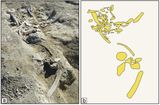Physicists achieve first entangled measurement of W states
Imagine two particles so interconnected that measuring one immediately reveals information about the other, even if the particles are light–years apart. This phenomenon, known as quantum entanglement, is the foundation of a variety of technologies such as quantum cryptography and quantum computing. However, entangled states are notoriously difficult to control. Now, for the first time, a team of physicists in Japan has performed a collective quantum measurement on a W state comprising three entangled photons. This allowed them to analyse the three entangled photons at once rather than one at a time. This achievement, reported in Science Advances, marks a significant step towards the practical development of quantum technologies.
Physicists usually measure entangled particles using a technique known as quantum tomography. In this method, many identical copies of a particle are prepared, and each copy is measured at a different angle. The results of these measurements are then combined to reconstruct its full quantum state. To visualize this, imagine being asked to take a family photo. Instead of taking one group picture, you have to photograph each family member individually and then combine all the photos into a single portrait. Now imagine taking a photo properly: taking one photograph of the entire family. This is essentially what happens in an entangled measurement: where all particles are measured simultaneously rather than separately. This approach allows for significantly faster and more efficient measurements.
So far, for three-particle systems, entangled measurements have only been performed on Greenberger–Horne–Zeilinger (GHZ) states, where all qubits (quantum bits of a system) are either in one state or another. Until now, no one had carried out an entangled measurement for a more complicated set of states known as W states, which do not share this all-or-nothing property. In their experiment, the researchers at Kyoto University and Hiroshima University specifically used the simplest type of W state, made up of three photons, where each photon’s polarization (horizontal or vertical) is represented by one qubit.
“In a GHZ state, if you measure one qubit, the whole superposition collapses. But in a W state, even if you measure one particle, entanglement still remains,” explains Shigeki Takeuchi, corresponding author of the paper describing the study. This robustness makes the W state particularly appealing for quantum technologies.
Fourier transformations
The team took advantage of the fact that different W states look almost identical but differ by tiny phase shift, which acts as a hidden label that distinguishes one state from another. Using a tool called a discrete Fourier transform (DFT) circuit, researchers were able to “decode” this phase and tell the states apart.
The DFT exploits a special type of symmetry inherent to W states. Since the method relies on symmetry, in principle it can be extended to systems containing any number of photons. The researchers prepared photons in controlled polarization states and ran them through the DFT, which provided each state’s phase label. After, the photons were sent through polarizing beam splitters that separate them into vertically and horizontally polarized groups. By counting both sets of photons, and combining this with information from the DFT, the team could identify the W state.
The experiment identified the correct W state about 87% of the time, well above the 15% success rate typically achieved using tomography-based measurements. Maintaining this level of performance was a challenge, as tiny fluctuations in optical paths or photon loss can easily destroy the fragile interference pattern. The fact that the team could maintain stable performance long enough to collect statistically reliable data marks an important technical milestone.
Scalable to larger systems
“Our device is not just a single-shot measurement: it works with 100% efficiency,” Takeuchi adds. “Most linear optical protocols are probabilistic, but here the success probability is unity.” Although demonstrated with three photons, this procedure is directly scalable to larger systems, as the key insight is the symmetry that the DFT can detect.
“In terms of applications, quantum communication seems the most promising,” says Takeuchi. “Because our device is highly efficient, our protocol could be used for robust communication between quantum computer chips. The next step is to build all of this on a tiny photonic chip, which would reduce errors and photon loss and help make this technology practical for real quantum computers and communication networks.”
The post Physicists achieve first entangled measurement of W states appeared first on Physics World.


















.gif)
